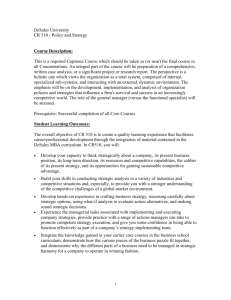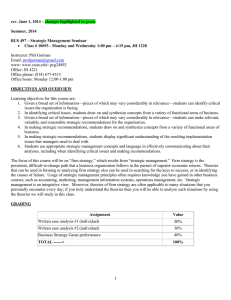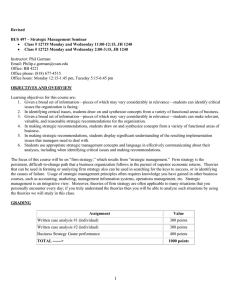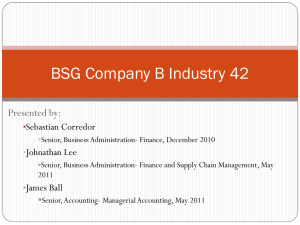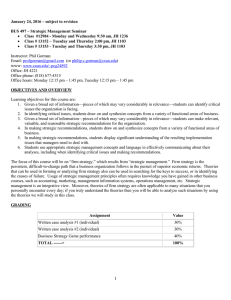v01 - California State University, Northridge
advertisement
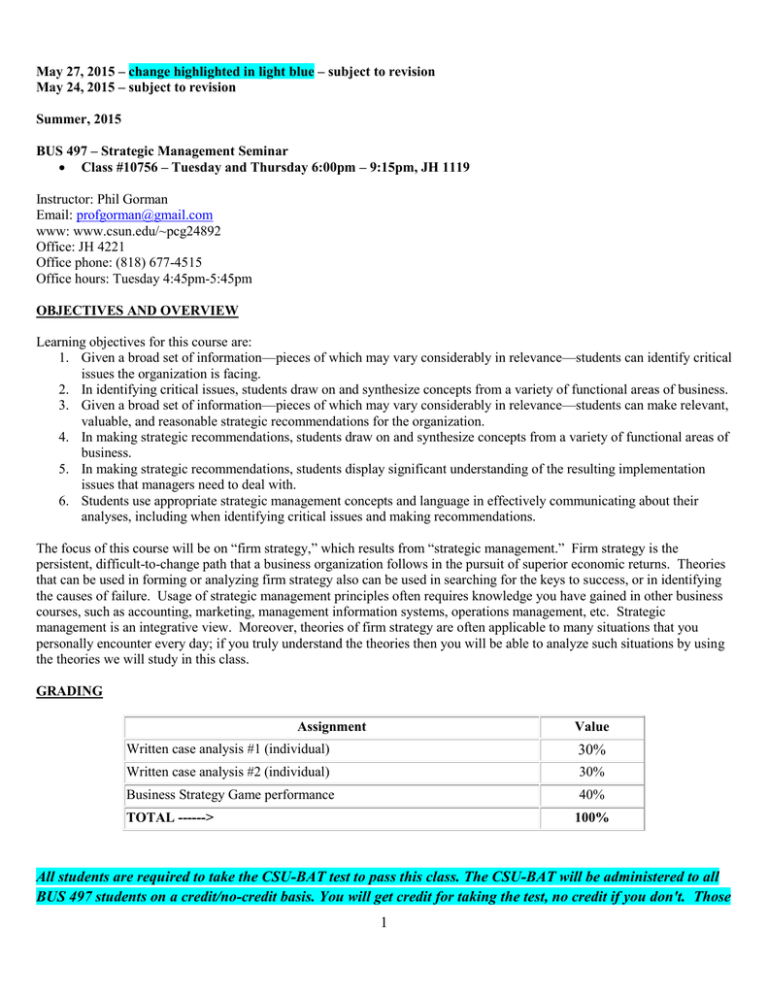
May 27, 2015 – change highlighted in light blue – subject to revision May 24, 2015 – subject to revision Summer, 2015 BUS 497 – Strategic Management Seminar Class #10756 – Tuesday and Thursday 6:00pm – 9:15pm, JH 1119 Instructor: Phil Gorman Email: profgorman@gmail.com www: www.csun.edu/~pcg24892 Office: JH 4221 Office phone: (818) 677-4515 Office hours: Tuesday 4:45pm-5:45pm OBJECTIVES AND OVERVIEW Learning objectives for this course are: 1. Given a broad set of information—pieces of which may vary considerably in relevance—students can identify critical issues the organization is facing. 2. In identifying critical issues, students draw on and synthesize concepts from a variety of functional areas of business. 3. Given a broad set of information—pieces of which may vary considerably in relevance—students can make relevant, valuable, and reasonable strategic recommendations for the organization. 4. In making strategic recommendations, students draw on and synthesize concepts from a variety of functional areas of business. 5. In making strategic recommendations, students display significant understanding of the resulting implementation issues that managers need to deal with. 6. Students use appropriate strategic management concepts and language in effectively communicating about their analyses, including when identifying critical issues and making recommendations. The focus of this course will be on “firm strategy,” which results from “strategic management.” Firm strategy is the persistent, difficult-to-change path that a business organization follows in the pursuit of superior economic returns. Theories that can be used in forming or analyzing firm strategy also can be used in searching for the keys to success, or in identifying the causes of failure. Usage of strategic management principles often requires knowledge you have gained in other business courses, such as accounting, marketing, management information systems, operations management, etc. Strategic management is an integrative view. Moreover, theories of firm strategy are often applicable to many situations that you personally encounter every day; if you truly understand the theories then you will be able to analyze such situations by using the theories we will study in this class. GRADING Assignment Value Written case analysis #1 (individual) 30% Written case analysis #2 (individual) 30% Business Strategy Game performance 40% TOTAL ------> 100% All students are required to take the CSU-BAT test to pass this class. The CSU-BAT will be administered to all BUS 497 students on a credit/no-credit basis. You will get credit for taking the test, no credit if you don't. Those 1 who score in the top 50% of CSUN students will get 3 extra credit points on your overall course score. The exam will be administered outside of class over a one-or-two-week period during June 17-19. You are responsible for signing up to take the test, showing up at the appointed time, and completing the test. Additional information will be given in class. Visit http://doodle.com/imc9rgp6mex4cigz to sign up for the CSU-BAT. Written case analyses Your written case analyses will be evaluated in much the same way as your performance in a debate would be evaluated. Do a full analysis and reach your conclusion. State your conclusions clearly, completely, and concisely, and back them up using models from the textbook, lectures, and other things we have done in class. See the “class schedule” portion of the syllabus for the dates of the written case analyses. In the written case analyses, you will receive a set of questions to answer. In answering the questions, you should use models/theories that you will be learning about during the semester by reading chapters in the textbook, by reviewing the online lectures, and by paying attention during class discussions. Business Strategy Game (BSG) Each group of around three or four students will be assigned in a non-democratic process, and will be the management team of one company in the global footwear industry. Your management team should thoroughly understand the way the industry works and the way a company in the industry works. Read and understand the BSG Player’s Manual; details will be discussed in class. You should thoroughly understand the components of each yearly decision and the interrelatedness and consequences of those components. In making your decisions, you will need to recall and integrate much of what you have learned during your education in business administration at CSUN. Be especially alert in the first years: As in real-world competition, the company that digs itself into an early hole may still be paying the consequences many years later! Each group member will receive a grade that will be determined mainly by his/her company’s performance in the industry. Your grade for the BSG also depends on your group members’ perceptions, relayed to me in a confidential survey near the end of the semester; each student is required to fill out and turn in this survey. Your individual score may suffer substantially if you have not made a sufficient contribution to your group's effort toward managing your company. When you log into the BSGonline.com www site, you should review the schedule of assignments that are due. Each team's decisions must be completed online by the appointed time each week. The industry will run through at least Year 15 and perhaps through Year 17; within those bounds, the final year will be identified only after that year has run. Note that this is not a lot of years, and there is little margin for error if your company gets off on the wrong foot. Thus, I very strongly recommend that you budget time to become very familiar with the Player’s Manual well before the Practice Round starts, and that you budget plenty of time for Year 11 and Year 12 to be sure every team member is ready to contribute and to make sure your company gets off on the right foot. There will be a practice round, and everyone should use that practice round to understand how the BSG works and how your team works. MISCELLANEOUS NOTICES Any instances of academic dishonesty will not be tolerated and I will deal with them under the guidelines stated in the Undergraduate/Graduate Catalog. All sources used in performing research for assignments in this course must be properly cited. The plus/minus system will be used when final grades are assigned. The College of Business and Economics at California State University, Northridge prepares students to be ethical decision makers. The college maintains high standards of ethical conduct that students are expected to maintain throughout their 2 academic and professional careers. Please view the “core values” at http://www.csun.edu/busecon/sites/default/files/corevalues_0.pdf. COURSE MATERIALS Gregory Dess, G.T. Lumpkin, Marilyn Taylor (2011). Strategic Management: Creating Competitive Advantages o Publisher: Irwin/McGraw-Hill o Language: English o the paperback volume without cases, if available (you can buy the one with cases if you wish, but we will not be using those cases) o IMPORTANT MONEY-SAVING NOTE: If you can find another textbook for a favorable price, that can work just fine. The previous edition of any one of those textbooks can work just fine, and you probably can find them online for under $10. If you choose to use a textbook other than the textbook authored by Dess, Lumpkin & Taylor, be sure to check with me so I can provide a crosswalk between the Tables of Contents of the two textbooks. Below you'll see a list of textbooks that can be used in this class in lieu of the one listed above. The reason I offer this alternative is to give students the ability to save substantial money. If you choose to use an alternate textbook, feel free to ask me if you have questions about which chapters in the alternate textbook relate to which topics are listed in the syllabus “class schedule” portion of this syllabus. If you choose to purchase one of these textbooks, make sure the publication date is within the past five years or so. Title Strategic Management Strategic Management Strategic Management : Formulation, Implementation & Control Strategic Management: Competitiveness & Globalization Strategic Management : An Integrated Approach Contemporary Strategy Analysis Author(s) Dess, Lumpkin, Taylor Thompson & Strickland Pearce & Robinson Hitt, Ireland & Hoskisson Hill & Jones Grant Packet of case studies (cases are listed below in the “class schedule” section of this syllabus); published by Harvard Business School Publishing. o See link on my www site The Business Strategy Game: Competing in a Global Marketplace o Player’s Program o Register online; registration details will be provided probably at the second class meeting. 3 CLASS SCHEDULE Note that in the “textbook readings” section below, I recognize that students will be using a number of different textbooks, and the titles of the chapters may vary somewhat. But by using the hints I’ve given below, you should be able to easily determine which chapter or chapters are the relevant ones for each assigned reading. While all strategy textbooks are arranged differently and use different chapter headings, they all contain the key chapter topics I have assigned below. If you have any questions about which chapter in your textbook is the best fit, please come talk with me and I will take a look at your textbook. It also is helpful to look at the index in the textbook for the key phrases I have listed below. Week 1 Week start date Week of May 25 Topic Trump game Introduction to class; overview of syllabus Textbook readings In textbook: review a chapter that will be titled something like “The concept of strategy” (almost always chapter 1) Characteristics of strategic decisions Analyzing the general environment BSG overview (Thursday) 2 Week of June 1 Form BSG teams; practice round begins (Thursday) Business ethics and corporate social responsibility Analyzing the industry environment 3 Week of June 8 Review BSG practice round results (Thursday) Case - Wal-Mart In the textbook, review the chapter that seems most focused on (according to the index or chapter titles) the phrase “general environment” or “external environment” In the textbook, review the chapter or chapters that seems most focused on (according to the index or chapter titles) key words such as “external environment,” or “industry environment” Assignment due Start thinking about what kind of company you want to build in the BSG Review BSG Player’s Manual (it is on my www site) BSG practice round begins (Thursday) BSG practice round decisions due, noontime, Thursday Practice round results disappear noontime Friday BSG Y11 decisions due, midnight Monday Case – Nintendo 4 Week of June 15 Case - Apple Business/competitive strategy Strategy implementation and organizational control BSG team meeting time (Tuesday, Thursday) In the textbook, review the chapter that seems most focused on (according to the index or chapter titles) key words such as “competitive advantage” or “competitive strategy” or “business strategy Case – Cereal industry 4 BSG Y12 decisions due, midnight Wednesday BSG Y13 decisions due, midnight Monday BSG Y14 decisions due, midnight Wednesday 5 Week of June 22 Corporate strategy Case - Calyx & Corolla In the textbook, review the chapter that lists “corporate strategy” as a topic BSG Y16 decisions due, midnight Wednesday Case - Coors in the Brewing Industry 6 Week of June 29 BSG Y15 decisions due, midnight Monday Written case analysis #1 due probably Tuesday, June 23 at the beginning of class BSG Y17 decisions due, midnight Monday Case - Banc One Case – Newell Case - BRL Hardy Case – eHarmony 7 Week of July 6 (Tuesday, July 7) Possible BSG team presentations Possible BSG team presentations Written case analysis #2 Written case analysis #2 5
